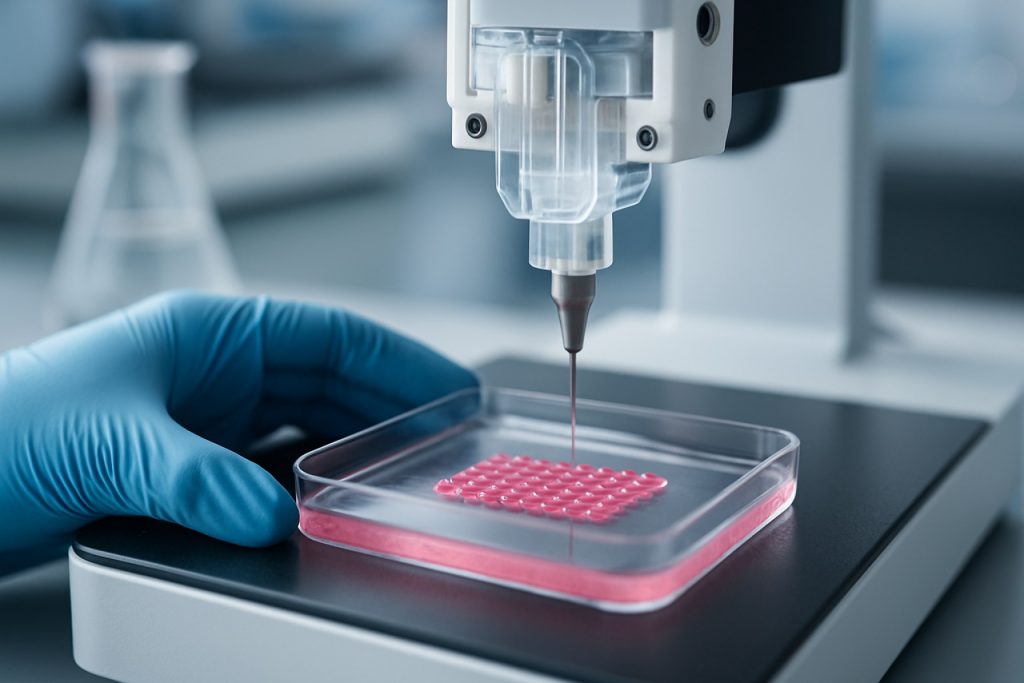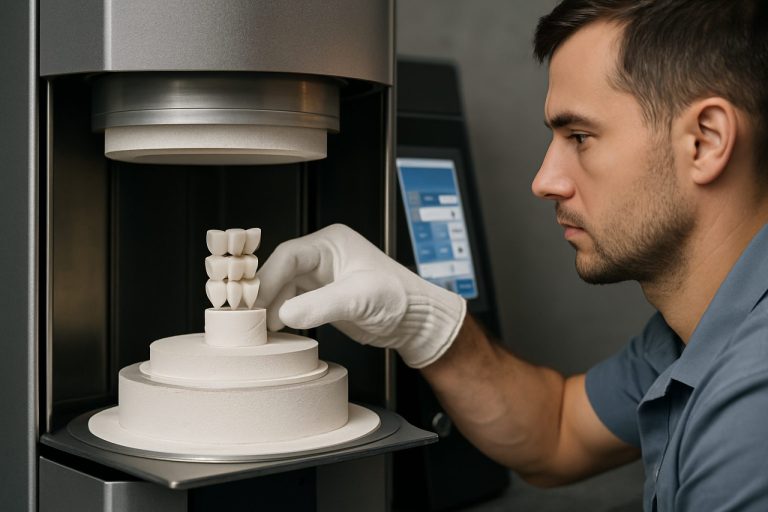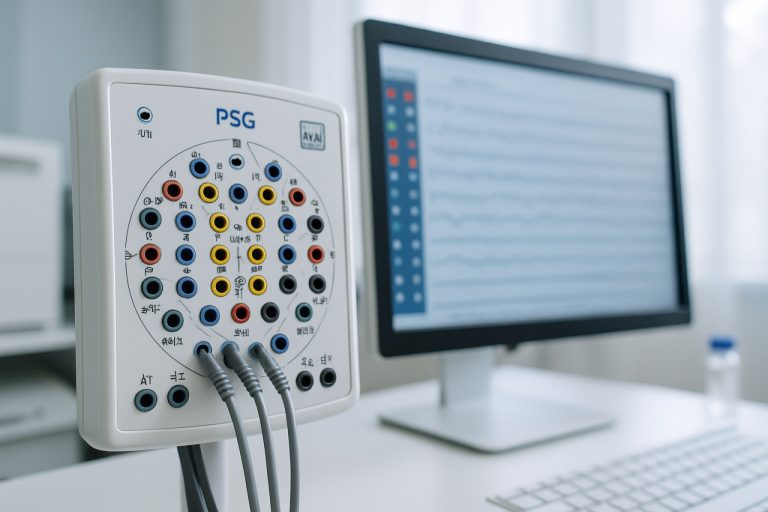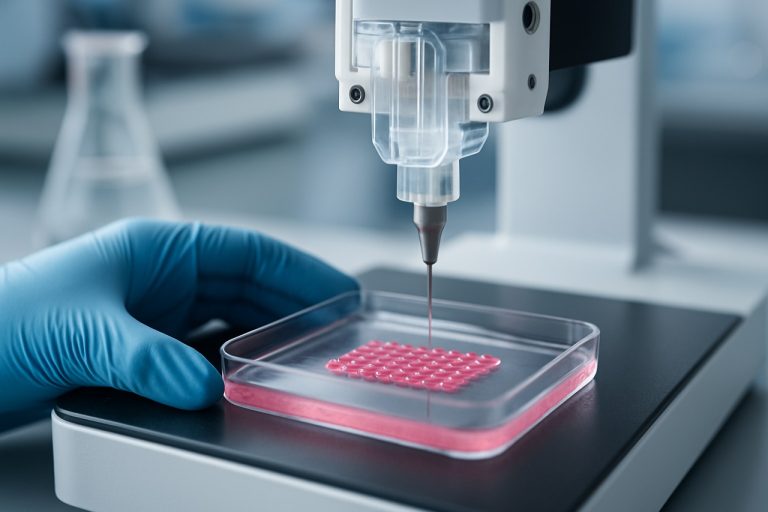
Microfluidic Inkjet Bioprinting in 2025: Unleashing Next-Gen Precision for Tissue Engineering and Regenerative Medicine. Explore the Breakthroughs, Market Trajectory, and Future Impact of This Transformative Technology.
- Executive Summary: Key Trends and Market Drivers in 2025
- Technology Overview: Microfluidic Inkjet Bioprinting Fundamentals
- Competitive Landscape: Leading Companies and Innovators
- Market Size and Forecasts: 2025–2030 Growth Projections
- Emerging Applications: Tissue Engineering, Drug Discovery, and Beyond
- Materials and Bioinks: Innovations and Supply Chain Insights
- Regulatory Environment and Industry Standards
- Challenges and Barriers to Commercialization
- Strategic Partnerships and Investment Activity
- Future Outlook: Disruptive Potential and Long-Term Opportunities
- Sources & References
Executive Summary: Key Trends and Market Drivers in 2025
Microfluidic inkjet bioprinting is poised for significant advancements and market expansion in 2025, driven by technological innovation, increased investment, and growing demand for precision-engineered biological constructs. This technique, which leverages microfluidic control to deposit bioinks with high spatial resolution, is increasingly recognized for its ability to fabricate complex tissue structures, organoids, and cell-laden scaffolds with enhanced viability and functionality.
A key trend in 2025 is the integration of advanced microfluidic printheads with real-time monitoring and feedback systems, enabling higher throughput and reproducibility. Companies such as CELLINK (a BICO company) and Organovo Holdings, Inc. are at the forefront, offering commercial microfluidic bioprinters that support multi-material and multi-cell printing. These systems are increasingly adopted by research institutions and pharmaceutical companies for applications in drug discovery, disease modeling, and regenerative medicine.
Another driver is the refinement of bioink formulations tailored for microfluidic inkjet systems. The development of shear-thinning, cell-compatible hydrogels and the incorporation of growth factors or extracellular matrix components are enhancing print fidelity and post-print cell survival. CELLINK and Allevi, Inc. (now part of 3D Systems) are notable for their expanding portfolios of standardized and custom bioinks, supporting a wider range of tissue engineering applications.
Regulatory and standardization efforts are also shaping the landscape. Industry bodies such as ASTM International are working on guidelines for bioprinting processes and materials, which is expected to accelerate clinical translation and commercial adoption. The establishment of quality benchmarks is particularly relevant as microfluidic inkjet bioprinting moves from prototyping to the production of implantable tissues and personalized therapeutics.
Looking ahead, the market outlook for microfluidic inkjet bioprinting remains robust. The convergence of microfluidics, automation, and artificial intelligence is anticipated to further improve process control and scalability. Strategic collaborations between bioprinter manufacturers, bioink developers, and end-users are likely to yield new applications, particularly in personalized medicine and high-throughput screening. As the technology matures, the sector is expected to see increased participation from established life science companies and new entrants, reinforcing its role as a cornerstone of next-generation biomanufacturing.
Technology Overview: Microfluidic Inkjet Bioprinting Fundamentals
Microfluidic inkjet bioprinting is a rapidly advancing technology that merges the precision of inkjet printing with the controlled fluid handling of microfluidics to fabricate complex biological structures. As of 2025, this approach is gaining traction for its ability to deposit living cells, biomaterials, and bioactive molecules with high spatial resolution and cell viability. The core principle involves ejecting picoliter to nanoliter droplets of bioink through microfluidic printheads, enabling the construction of tissue-like architectures layer by layer.
The technology leverages microfluidic channels integrated within the printhead to precisely control the flow, mixing, and dispensing of multiple bioinks. This allows for on-demand formulation and rapid switching between different cell types or materials during the printing process. Unlike traditional inkjet systems, microfluidic inkjet bioprinters can handle higher cell densities and more viscous bioinks, which are essential for replicating the complexity of native tissues.
Key industry players are actively developing and commercializing microfluidic inkjet bioprinting platforms. CELLINK, a subsidiary of BICO Group, is recognized for its modular bioprinting systems that incorporate microfluidic printheads, supporting research in tissue engineering and regenerative medicine. Organovo Holdings, Inc. has also contributed to the field by advancing bioprinting technologies for creating functional human tissues for drug discovery and disease modeling. Roland DG Corporation, traditionally known for digital printing, has expanded into bioprinting, leveraging its expertise in precision inkjet technology to develop systems suitable for biological applications.
Recent developments focus on improving printhead design, droplet control, and bioink compatibility. For example, the integration of real-time monitoring and feedback systems is enhancing print fidelity and reproducibility. Additionally, advances in microfluidic chip fabrication—such as the use of biocompatible polymers and 3D-printed microchannels—are enabling more complex and customizable printhead architectures.
Looking ahead to the next few years, the outlook for microfluidic inkjet bioprinting is promising. Ongoing research aims to scale up the technology for larger tissue constructs and to integrate multi-material and multi-cellular printing capabilities. The convergence of microfluidics, automation, and artificial intelligence is expected to further streamline the design-to-print workflow, making the technology more accessible for clinical and industrial applications. As regulatory frameworks evolve and standardization efforts intensify, microfluidic inkjet bioprinting is poised to play a pivotal role in the future of personalized medicine, drug screening, and tissue engineering.
Competitive Landscape: Leading Companies and Innovators
The competitive landscape for microfluidic inkjet bioprinting in 2025 is characterized by a dynamic mix of established players, emerging startups, and cross-disciplinary collaborations. This sector is driven by the convergence of microfluidics, precision engineering, and biofabrication, with companies racing to commercialize platforms for tissue engineering, regenerative medicine, and pharmaceutical research.
Among the most prominent companies, CELLINK (a BICO company) continues to be a global leader in bioprinting technologies, including microfluidic inkjet systems. CELLINK’s portfolio features modular bioprinters and bioinks, with ongoing R&D into microfluidic printheads that enable high-throughput, multi-material deposition. Their collaborations with academic and clinical partners are accelerating the translation of microfluidic inkjet bioprinting into real-world applications.
Another key innovator is Organovo Holdings, Inc., which has a strong focus on 3D bioprinted tissues for drug discovery and disease modeling. Organovo’s proprietary bioprinting platforms are being adapted to incorporate microfluidic inkjet technologies, aiming to improve cell viability and spatial resolution in printed constructs. The company’s partnerships with pharmaceutical firms are expected to yield new preclinical models in the next few years.
In the instrumentation space, Stratasys Ltd.—a leader in additive manufacturing—has expanded its bioprinting capabilities through acquisitions and internal development. Stratasys is investing in microfluidic printhead design to enable precise droplet control and multiplexed bioink delivery, targeting both research and clinical markets.
Startups are also making significant contributions. Aspect Biosystems is notable for its microfluidic 3D bioprinting platform, which leverages proprietary printhead technology to fabricate functional tissue structures. The company’s partnerships with biotechnology and pharmaceutical firms are expected to drive new product launches and clinical collaborations through 2025 and beyond.
On the materials side, Thermo Fisher Scientific Inc. supplies a range of bioinks and reagents compatible with microfluidic inkjet bioprinters, supporting both commercial and academic users. Their ongoing investment in cell-compatible materials and quality control is helping to standardize workflows across the industry.
Looking ahead, the competitive landscape is likely to see further consolidation as larger players acquire innovative startups to expand their technology portfolios. Strategic alliances between hardware manufacturers, materials suppliers, and end-users are expected to accelerate the adoption of microfluidic inkjet bioprinting in tissue engineering, personalized medicine, and drug screening. The next few years will be pivotal as companies race to achieve regulatory milestones and demonstrate clinical utility, setting the stage for broader commercialization and impact.
Market Size and Forecasts: 2025–2030 Growth Projections
Microfluidic inkjet bioprinting is poised for significant growth between 2025 and 2030, driven by advances in precision cell deposition, increasing demand for tissue engineering, and the expansion of regenerative medicine applications. The technology leverages microfluidic control to enable high-resolution, drop-on-demand printing of living cells and biomaterials, offering advantages in cell viability and patterning over traditional bioprinting methods.
Key industry players are investing in the development and commercialization of microfluidic inkjet bioprinters. CELLINK, a subsidiary of BICO Group, is a prominent manufacturer offering modular bioprinting platforms that integrate microfluidic printheads for multi-material and multi-cell printing. Organovo Holdings, Inc. continues to focus on 3D bioprinted tissues for drug discovery and disease modeling, with ongoing efforts to enhance print fidelity and throughput using microfluidic technologies. Roland DG Corporation, known for its precision inkjet systems, has expanded its portfolio to include bioprinting solutions, leveraging its expertise in microfluidics and printhead engineering.
The market is expected to see a compound annual growth rate (CAGR) in the double digits through 2030, as bioprinting moves from research laboratories into clinical and industrial settings. The adoption of microfluidic inkjet bioprinting is particularly strong in North America and Europe, where regulatory frameworks and funding for advanced biofabrication are robust. Asia-Pacific is also emerging as a key region, with increased investment in biomedical research and manufacturing infrastructure.
- In 2025, the global market for microfluidic inkjet bioprinting is projected to surpass several hundred million USD, with tissue engineering and regenerative medicine accounting for the largest share of demand.
- Pharmaceutical companies are increasingly partnering with bioprinter manufacturers to accelerate drug screening and personalized medicine initiatives, as evidenced by collaborations involving CELLINK and leading pharma firms.
- The next five years are expected to bring further integration of automation, real-time monitoring, and artificial intelligence into microfluidic bioprinting platforms, enhancing reproducibility and scalability.
Looking ahead, the outlook for microfluidic inkjet bioprinting is highly positive. The convergence of microfluidics, advanced biomaterials, and digital manufacturing is set to unlock new applications in organ-on-chip models, custom implants, and high-throughput screening. As companies like CELLINK, Organovo Holdings, Inc., and Roland DG Corporation continue to innovate, the sector is expected to play a pivotal role in the future of biomanufacturing and personalized healthcare.
Emerging Applications: Tissue Engineering, Drug Discovery, and Beyond
Microfluidic inkjet bioprinting is rapidly advancing as a transformative technology in tissue engineering, drug discovery, and related biomedical fields. As of 2025, the integration of microfluidics with inkjet bioprinting is enabling unprecedented precision in the deposition of living cells, biomaterials, and bioactive molecules, opening new avenues for the fabrication of complex tissue constructs and high-throughput screening platforms.
In tissue engineering, microfluidic inkjet bioprinting is being leveraged to create highly organized, multicellular structures that closely mimic native tissue architecture. Companies such as CELLINK and Organovo Holdings, Inc. are at the forefront, developing bioprinters and bioinks tailored for the fabrication of vascularized tissues, skin, and organoids. These advances are facilitating the production of functional tissue models for regenerative medicine and transplantation research. For example, the ability to precisely control droplet size and cell placement is enabling the creation of microvascular networks, a critical step toward engineering larger, viable tissues.
In drug discovery, microfluidic inkjet bioprinting is revolutionizing the development of physiologically relevant in vitro models. The technology allows for the rapid and reproducible fabrication of 3D cell cultures and organ-on-a-chip systems, which are increasingly used for high-throughput drug screening and toxicity testing. 3D Biomatrix and TissUse GmbH are notable for their work in developing microfluidic platforms that integrate with bioprinting to produce multi-tissue models, enhancing the predictive power of preclinical assays and reducing reliance on animal testing.
Beyond traditional biomedical applications, microfluidic inkjet bioprinting is finding roles in personalized medicine, biosensor fabrication, and the development of advanced biomaterials. The technology’s ability to deposit multiple cell types and materials with high spatial resolution is enabling the creation of patient-specific tissue models and implantable devices. Companies like Aspect Biosystems are pioneering the use of microfluidic printheads to engineer functional tissue therapeutics, with several preclinical programs underway targeting musculoskeletal and metabolic diseases.
Looking ahead, the next few years are expected to see further integration of artificial intelligence and automation with microfluidic inkjet bioprinting platforms, driving improvements in reproducibility, scalability, and throughput. As regulatory frameworks evolve and clinical translation accelerates, the technology is poised to play a central role in the development of next-generation therapies and research tools.
Materials and Bioinks: Innovations and Supply Chain Insights
Microfluidic inkjet bioprinting is rapidly advancing, with 2025 marking a pivotal year for innovations in materials and bioinks, as well as the maturation of the supply chain supporting this technology. The core of microfluidic inkjet bioprinting lies in its ability to precisely deposit picoliter droplets of cell-laden bioinks, enabling the fabrication of complex tissue constructs with high spatial resolution. This precision has driven demand for bioinks with tailored rheological and biological properties, spurring significant research and commercial activity.
Recent years have seen a surge in the development of next-generation bioinks, particularly those based on natural polymers such as alginate, gelatin methacrylate (GelMA), and collagen, as well as synthetic hydrogels designed for tunable mechanical strength and cell compatibility. Companies like CELLINK (a BICO company) have expanded their portfolios to include a wide range of standardized and custom bioinks optimized for microfluidic inkjet systems. These bioinks are engineered for low viscosity and high cell viability, addressing the unique requirements of inkjet-based deposition.
In parallel, suppliers such as Allevi (now part of 3D Systems) and Organovo are focusing on the scalability and reproducibility of bioink production, ensuring batch-to-batch consistency and regulatory compliance. This is crucial as the field moves toward clinical and industrial applications, where traceability and quality assurance are paramount. The supply chain is also being strengthened by partnerships between bioink developers and microfluidic chip manufacturers, such as Dolomite Microfluidics, which provides microfluidic components tailored for bioprinting workflows.
Material innovation is not limited to bioinks. The integration of functional nanoparticles, growth factors, and extracellular matrix (ECM) components into printable formulations is enabling the creation of more physiologically relevant tissue models. For example, CELLINK and Organovo are actively developing composite bioinks that support vascularization and tissue maturation, addressing key challenges in tissue engineering.
Looking ahead to the next few years, the outlook for microfluidic inkjet bioprinting materials is robust. The sector is expected to benefit from advances in synthetic biology, allowing for the design of “smart” bioinks that respond to environmental cues or release bioactive molecules on demand. Additionally, the supply chain is likely to become more globalized and resilient, with increased investment in GMP-compliant manufacturing facilities and digital tracking systems for raw materials and finished products. As regulatory frameworks evolve, collaboration between industry leaders and standards organizations will be critical to ensure the safe and effective deployment of these innovative materials in both research and clinical settings.
Regulatory Environment and Industry Standards
The regulatory environment for microfluidic inkjet bioprinting is rapidly evolving as the technology matures and moves closer to clinical and commercial applications. In 2025, regulatory agencies are increasingly focused on establishing clear frameworks to ensure the safety, efficacy, and quality of bioprinted tissues and devices. The U.S. Food and Drug Administration (FDA) has been proactive in engaging with stakeholders through its Center for Devices and Radiological Health (CDRH), which oversees medical devices, including bioprinted constructs. The FDA’s Tissue Reference Group and the Office of Combination Products are also involved in clarifying the regulatory pathways for products that combine cells, biomaterials, and devices, which is typical in microfluidic inkjet bioprinting.
In the European Union, the Medical Device Regulation (MDR) and Advanced Therapy Medicinal Products (ATMP) frameworks are the primary regulatory routes for bioprinted products. The European Medicines Agency (EMA) is working with industry and academic partners to address the unique challenges posed by microfluidic bioprinting, such as the standardization of cell sources, bioinks, and printing processes. The International Organization for Standardization (ISO) has also initiated efforts to develop standards specific to bioprinting, building on existing standards for additive manufacturing (ISO/ASTM 52900) and medical devices (ISO 13485).
Industry leaders are actively participating in shaping these standards. CELLINK, a prominent bioprinting company, collaborates with regulatory bodies and standards organizations to ensure their microfluidic inkjet platforms meet emerging requirements. Organovo Holdings, Inc., known for its work in 3D bioprinted tissues, is also engaged in regulatory discussions, particularly regarding preclinical validation and quality control of bioprinted constructs. 3D Systems, Inc., which acquired bioprinting specialist Allevi, is contributing to the development of best practices for device and process validation.
A key trend in 2025 is the push for harmonization of standards across regions to facilitate global commercialization and clinical translation. Industry consortia, such as the Alliance for Regenerative Medicine, are advocating for risk-based, product-specific regulatory approaches that recognize the unique aspects of microfluidic inkjet bioprinting. There is also growing emphasis on digital traceability, process monitoring, and data integrity, with companies investing in software and hardware solutions to support regulatory compliance.
Looking ahead, the next few years are expected to see the publication of new ISO and ASTM standards tailored to bioprinting, as well as the first regulatory approvals of microfluidic inkjet bioprinted products for clinical use. This evolving landscape will require ongoing collaboration between industry, regulators, and standards bodies to ensure that innovation in microfluidic inkjet bioprinting is matched by robust safety and quality oversight.
Challenges and Barriers to Commercialization
Microfluidic inkjet bioprinting, a technology that enables precise deposition of living cells and biomaterials, is advancing rapidly but faces several significant challenges and barriers to widespread commercialization as of 2025. These hurdles span technical, regulatory, and market-related domains, impacting both established players and emerging startups in the sector.
A primary technical challenge is the reliable handling and viability of biological materials during the printing process. Maintaining cell viability and function is critical, as the shear forces and thermal stresses inherent in inkjet-based systems can damage sensitive cell types. Companies such as CELLINK and Organovo Holdings, Inc. are actively developing proprietary printhead designs and bioink formulations to mitigate these effects, but achieving consistent results across diverse cell types remains a barrier.
Another major obstacle is the scalability and reproducibility of printed constructs. While microfluidic inkjet systems offer high resolution, scaling up from laboratory prototypes to clinically relevant tissue sizes without compromising structural integrity or biological function is complex. The integration of microfluidics with multi-material printing, as pursued by Roland DG Corporation and Stratasys Ltd., is promising but still in early stages for bioprinting applications.
Regulatory approval is a further barrier, particularly for applications involving human implantation or therapeutic use. The lack of standardized protocols and the novelty of microfluidic inkjet bioprinting complicate the pathway to approval from agencies such as the U.S. Food and Drug Administration (FDA). Industry groups, including the ASTM International, are working to develop consensus standards for bioprinting, but harmonization across jurisdictions is still years away.
Material supply chain issues also persist. The sourcing of high-quality, GMP-compliant bioinks and the need for sterile, disposable microfluidic cartridges add cost and complexity. Companies like Thermo Fisher Scientific Inc. are expanding their offerings in cell culture reagents and bioinks, but widespread, cost-effective availability is not yet realized.
Finally, market adoption is hindered by high capital costs and the need for specialized technical expertise. Training end-users and demonstrating clear value propositions—such as improved drug screening or personalized medicine—are essential for broader uptake. Industry leaders are investing in educational initiatives and collaborative research, but the transition from research to routine clinical or industrial use is expected to remain gradual through the next several years.
In summary, while microfluidic inkjet bioprinting holds transformative potential, overcoming these technical, regulatory, and economic barriers will be crucial for its commercial success in the near future.
Strategic Partnerships and Investment Activity
Strategic partnerships and investment activity in the microfluidic inkjet bioprinting sector have accelerated into 2025, reflecting the technology’s maturation and its growing relevance to regenerative medicine, drug discovery, and tissue engineering. The field is characterized by collaborations between bioprinting technology developers, pharmaceutical companies, academic institutions, and materials suppliers, all aiming to advance the precision and scalability of cell-based printing.
A notable driver of recent activity is the convergence of microfluidics and inkjet bioprinting, which enables high-throughput, multi-material deposition with single-cell resolution. Companies such as CELLINK (a BICO company) have been at the forefront, expanding their microfluidic printhead offerings and forming alliances with research hospitals and pharmaceutical firms to co-develop tissue models and organ-on-chip systems. In 2024, CELLINK announced new partnerships with leading European research consortia to integrate microfluidic inkjet platforms into preclinical drug screening pipelines.
Another key player, Organovo Holdings, Inc., has continued to attract investment for its proprietary bioprinting technologies, which leverage microfluidic control for precise cell placement. The company’s collaborations with pharmaceutical giants have focused on developing disease models for liver and kidney tissues, with several multi-year agreements extended into 2025. These partnerships are often structured to combine Organovo’s bioprinting expertise with the pharma partners’ drug development pipelines, accelerating the validation of bioprinted tissue models for toxicity and efficacy testing.
On the instrumentation side, Stratasys Ltd. and 3D Systems, Inc. have both increased their investment in microfluidic inkjet bioprinting through acquisitions and joint ventures. In late 2024, 3D Systems, Inc. announced a strategic investment in a European microfluidics startup, aiming to integrate advanced droplet control into its bioprinting platforms. Similarly, Stratasys Ltd. has partnered with academic centers to co-develop next-generation printheads capable of handling living cells and complex bioinks.
Looking ahead, the sector is expected to see continued consolidation and cross-sector partnerships, particularly as regulatory agencies begin to recognize bioprinted tissues in preclinical workflows. The influx of venture capital and corporate investment is likely to accelerate commercialization, with a focus on scalable, GMP-compliant microfluidic inkjet systems. As the technology matures, partnerships between hardware manufacturers, bioink developers, and end-users will be critical to overcoming technical and regulatory hurdles, positioning microfluidic inkjet bioprinting as a cornerstone of next-generation biomedical manufacturing.
Future Outlook: Disruptive Potential and Long-Term Opportunities
Microfluidic inkjet bioprinting is poised to be a transformative force in the biofabrication landscape, with 2025 marking a pivotal year for both technological maturation and commercial adoption. This technique, which leverages the precision of microfluidics to deposit living cells and biomaterials in highly controlled patterns, is increasingly recognized for its potential to revolutionize tissue engineering, regenerative medicine, and pharmaceutical research.
Key industry players are accelerating innovation in this space. CELLINK, a subsidiary of BICO Group, continues to expand its portfolio of microfluidic-enabled bioprinters, focusing on high-throughput and multi-material capabilities. Their systems are being adopted by leading research institutions and pharmaceutical companies for applications ranging from 3D cell culture models to complex tissue constructs. Similarly, Organovo Holdings, Inc. is advancing the development of functional human tissues using proprietary bioprinting platforms, with a particular emphasis on disease modeling and drug discovery.
In 2025, the integration of microfluidic inkjet bioprinting with real-time monitoring and artificial intelligence is expected to enhance process control and reproducibility. Companies such as Stratasys Ltd. are investing in smart bioprinting solutions that combine microfluidic dispensing with advanced software analytics, aiming to reduce variability and improve scalability for clinical-grade tissue manufacturing.
The disruptive potential of microfluidic inkjet bioprinting lies in its ability to fabricate tissues with unprecedented spatial resolution and cell viability. This is particularly significant for the production of vascularized tissues, a longstanding challenge in regenerative medicine. Collaborative efforts between industry and academia are accelerating the translation of these technologies toward preclinical and, eventually, clinical applications. For example, 3D Systems, Inc. has partnered with research hospitals to develop bioprinted organ models for surgical planning and transplantation research.
Looking ahead, the next few years are expected to see the emergence of standardized bioinks and regulatory frameworks, which will be critical for the commercialization of bioprinted tissues and organs. Industry consortia and standards organizations are working to establish guidelines for quality assurance and safety, paving the way for broader adoption in healthcare and pharmaceutical sectors.
In summary, microfluidic inkjet bioprinting is on the cusp of disrupting traditional paradigms in tissue engineering and drug development. As hardware, software, and biological materials continue to advance, the technology is set to unlock long-term opportunities in personalized medicine, organ transplantation, and beyond, with 2025 serving as a launchpad for widespread impact.
Sources & References
- CELLINK
- Organovo Holdings, Inc.
- Allevi, Inc.
- ASTM International
- Roland DG Corporation
- Stratasys Ltd.
- Aspect Biosystems
- Thermo Fisher Scientific Inc.
- TissUse GmbH
- Dolomite Microfluidics
- 3D Systems, Inc.



